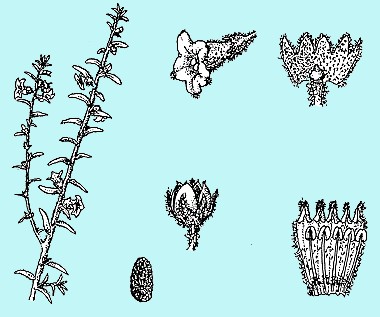 Line drawing by M. Perkins (L.Haegi, unpubl. thesis). |
 Part of an herbarium specimen of S. bancroftii (AD). |

Synonymy
Symonanthus bancroftii (F.Muell.) Haegi, Telopea 2: 175 (1981).
Isandra bancroftii F.Muell., S. Sci. Rec. 3: 2 (1883)
T: `between Stirling's Range and the eastern sources of Swan-River; Th. Muir'; syn: K.
Description
Erect shrub to 1 m. All parts grey-pubescent with dendritic hairs.
Leaves ovate, the lamina up to 8 cm long, and 4.5 cm wide, usually c. 5 cm long, 3 cm wide; petiole c. 1 cm long.
Inflorescence a congested cluster of 4–6 flowers; pedicels 3–5 mm long. Calyx 4–6 mm long at time of flowering; lobes shortly triangular with linear apices, 2–3 mm long. Corolla 5–6 mm long, dull yellow-green; lobes triangular, 1.5–3 mm long, spreading. Anthers 1 mm long. Ovary obtusely conical, 1–1.5 mm long; style 3 mm long.
Berry globular, 5–10 mm diam., shining red, surrounded by urn-shaped inflated calyx, the tube 15–20 mm long. Seeds more or less disc-shaped, 1.5–2.2 mm long, light brown.
Distribution and ecology
An extremely rare species known from only a few localities in the south-eastern wheatbelt region of south-western W.A.
The species was re-located in the Bruce Rock area in 1997, the first collection from there since 1932 (CALMNEWS September-October 1997, p. 4).
Notes
Phylogenetic studies by Garcia & Olmstead (2003) on the Tribe Anthocercideae using two chloroplast DNA regions included this species. The studies indicated that Symonanthus is monophyletic.
Reference: V.F.Garcia & R.G.Olmstead (2003). Phylogenetics of Tribe Anthocercideaea (Solanaceae) based on ndhF and trnL/F sequence data. Systematic Botany 28: 609-615.
Pharmacology
A discussion of the tropane alkaloids which occur in Symonanthus and other Anthocercideae can be found in Griffith & Lin (2000).
Ref: W.J. Griffin & G.D. Lin (2000). Chemotaxonomy and geographical distribution of tropane alkaloids. Phytochemistry 53: 627–628.
Selected specimens
W.A.: Bendering, Sept. 1922, C.A. Gardner (PERTH); Cummening, 1892, M. Heal (MEL); c. 15 km S of Katanning, R.H. Kuchel 1906 (AD).
Derivation of epithet
Named in honour of Dr Joseph Bancroft, 1836-1894, a surgeon in Queensland noted for for his pharmacological investigations of Australian plants.
Images and information on web
Further information and an image for this species in WA can be found on the FloraBase site.
Plant status (if any)
Declared as Rare Flora - Extant based on Atkins (2008). See http://florabase.calm.wa.gov.au/conservationtaxa
Atkins, K.J. (2008). Declared Rare and Priority Flora List for
Listed as Endangered under the Commonwealth EPBC Act - see www.environment.gov.au/cgi-bin/sprat/public/publicspecies.pl?taxon_id=12837